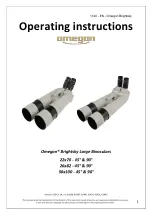
10
19
10
19
Adjustable Features
(continued)
Exposure
(continued)
In a lighted indoor environment, you may notice a pulsing or strobe effect at varying
exposure settings. In the U.S., or other countries with 60hertz electrical systems, exposure
rates other than 30fps and 15fps will be unsynchronized with the lighting system. The
iGen
®
is designed for outdoor use and for use in dark environments so this characteristic
does not affect the device’s performance; such a pulsing effect will only be evident when
testing or practicing with the iGen
®
in a lighted environment.
In countries with 50 hertz electrical systems, indoor pulsing will be apparent at all frame rates,
other thatn 25fps.
While light-gathering capability improves with longer exposure times, at exposure settings
below 15fps, the image will appear unnatural. Longer exposure settings (lower fps
numbers) present fewer and fewer image “snapshots” which are presented to you just as a
movie is a collection of frames repeated at 30 frames per second. Below 15fps, a moving
image may appear to move unevenly. Likewise, below 12fps, the image may shake as a
person is unable to hold the iGen
®
completely still. If you concentrate on holding the
device still, you should find the device very useful down to 10 or 12fps.
Adjustable Features
(continued)
Exposure
(continued)
In a lighted indoor environment, you may notice a pulsing or strobe effect at varying
exposure settings. In the U.S., or other countries with 60hertz electrical systems, exposure
rates other than 30fps and 15fps will be unsynchronized with the lighting system. The
iGen
®
is designed for outdoor use and for use in dark environments so this characteristic
does not affect the device’s performance; such a pulsing effect will only be evident when
testing or practicing with the iGen
®
in a lighted environment.
In countries with 50 hertz electrical systems, indoor pulsing will be apparent at all frame rates,
other thatn 25fps.
While light-gathering capability improves with longer exposure times, at exposure settings
below 15fps, the image will appear unnatural. Longer exposure settings (lower fps
numbers) present fewer and fewer image “snapshots” which are presented to you just as a
movie is a collection of frames repeated at 30 frames per second. Below 15fps, a moving
image may appear to move unevenly. Likewise, below 12fps, the image may shake as a
person is unable to hold the iGen
®
completely still. If you concentrate on holding the
device still, you should find the device very useful down to 10 or 12fps.
Infrared Emitter
The basic principle employed by iGen
®
is light amplification. In very dark conditions, where you
cannot see, and your eye cannot detect the small amount of light that is available, the iGen
®
detects and amplifies very small amounts of available light. But in the absence of any available
light, use the infrared emitter.
To understand how much light is available in different environments, review the following
table. Light intensity is measured in lux. One lux is roughly the amount of light created by a
candle at a distance of one meter.
The number of lux existing in different environments is:
Condition
Number of Lux
iGen
®
Function.
Sunny Day
100,000+
Too bright. Keep lens cap on.
Overcast Day
100 to 10,000
Too bright. Keep lens cap on.
Indoor Lighting
80 to 300
Keep lens cap on.
Street lighting at night
1 to 10
No IR(infrared emitter) needed.
Full Moon
0.1
No IR needed.
Quarter Moon
0.01
IR might be needed.
Clear night with no moon
0.001
IR necessary at distance.
Dark Cloudy Night
0.0001
IR absolutely necessary.
Infrared Emitter
The basic principle employed by iGen
®
is light amplification. In very dark conditions, where you
cannot see, and your eye cannot detect the small amount of light that is available, the iGen
®
detects and amplifies very small amounts of available light. But in the absence of any available
light, use the infrared emitter.
To understand how much light is available in different environments, review the following
table. Light intensity is measured in lux. One lux is roughly the amount of light created by a
candle at a distance of one meter.
The number of lux existing in different environments is:
Condition
Number of Lux
iGen
®
Function.
Sunny Day
100,000+
Too bright. Keep lens cap on.
Overcast Day
100 to 10,000
Too bright. Keep lens cap on.
Indoor Lighting
80 to 300
Keep lens cap on.
Street lighting at night
1 to 10
No IR(infrared emitter) needed.
Full Moon
0.1
No IR needed.
Quarter Moon
0.01
IR might be needed.
Clear night with no moon
0.001
IR necessary at distance.
Dark Cloudy Night
0.0001
IR absolutely necessary.

























